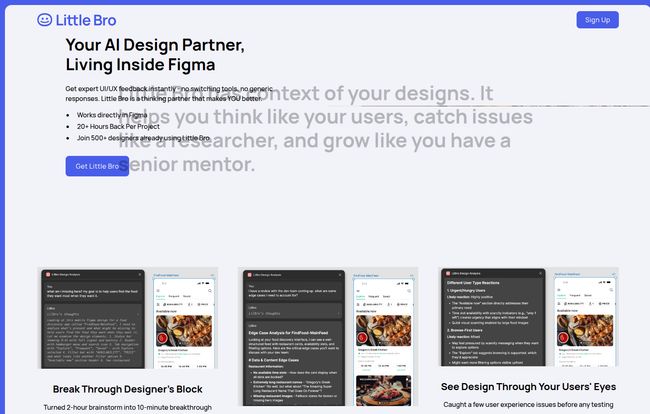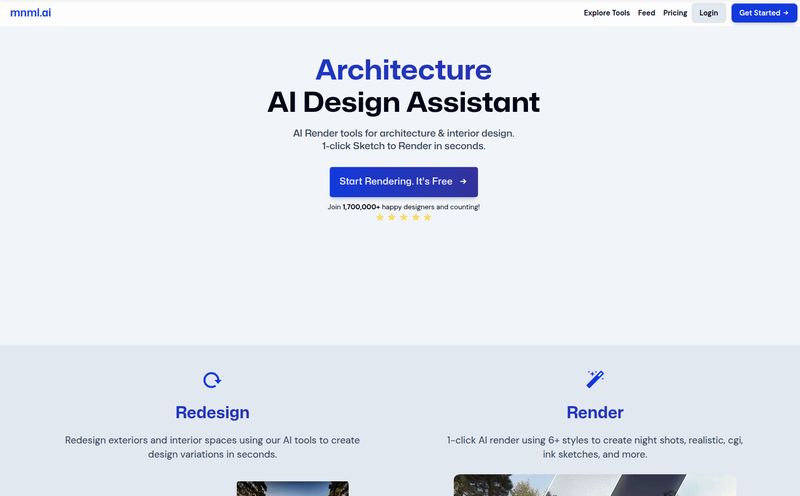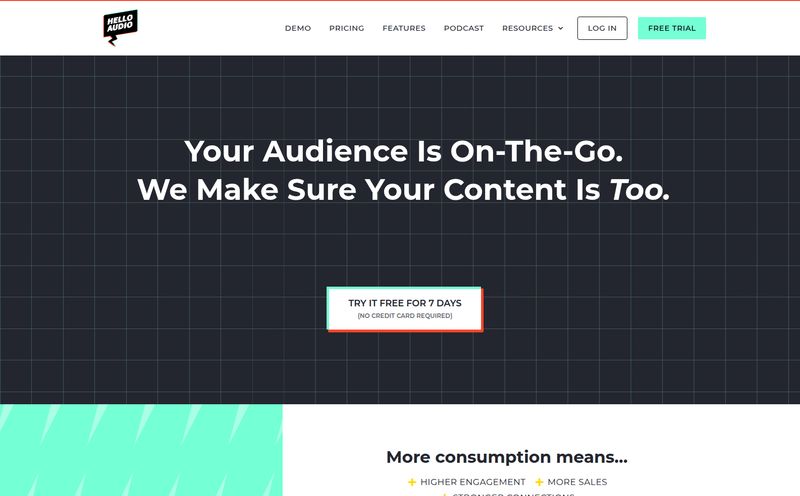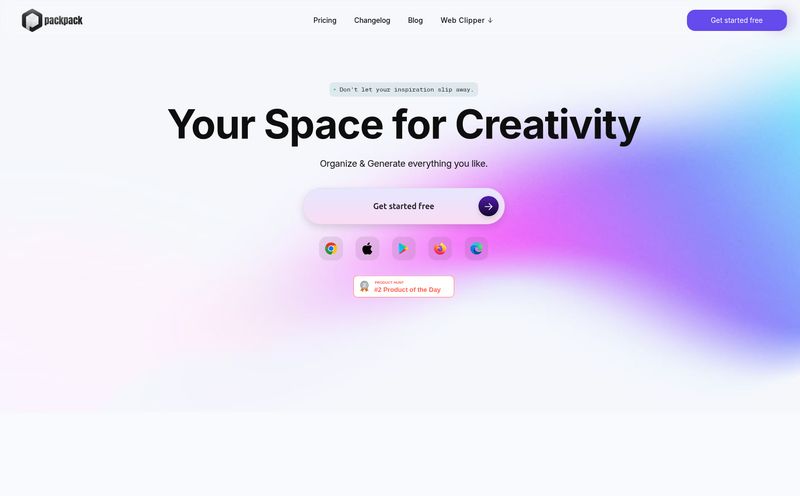The life of a UI/UX designer can be a lonely one. You’re staring at a screen, moving pixels, and pouring your soul into a layout that you think is brilliant. But then the doubt creeps in. Is this button intuitive? Does this flow make sense to anyone but me? You crave a second opinion, but your lead is swamped, and your cat… well, he’s not great with feedback on information architecture.
Then comes the AI hype train. Every week there's a new tool promising to revolutionize our workflow. Most of them, if I'm being brutally honest, are pretty generic. They spit out boilerplate advice that a first-year design student could give you. So when I heard about an AI design assistant called Little Bro, I was skeptical. The name alone is disarming, right? But the promise was different: an AI that acts less like a robot and more like a senior mentor or a research partner. One that helps you see your work through your users' eyes.
Okay, you have my attention. I decided to give it a spin.
So, What Is Little Bro, Really?
At its core, Little Bro is an AI-powered assistant built specifically for UI/UX designers. But that's a boring description. Think of it more like an on-demand, 24/7 knowledgeable colleague. The kind who’s always got time for your questions, never gets tired of looking at your iterations, and has an uncanny ability to spot that one weird edge case you totally missed.
Unlike other tools that give you vague feedback like “increase contrast,” Little Bro digs deeper. It's designed to simulate actual user behavior and psychology. It asks the hard questions: “How would a power user feel about this extra step?” or “What if someone is trying to use this on a slow 3G connection while juggling a coffee?” These are the things that keep us up at night. And frankly, having an AI to shoulder some of that cognitive load is a relief.

Visit Little Bro
The Features I Actually Used (And Loved)
A tool can have a million features, but what matters is what actually moves the needle in your day-to-day. After playing around, a few things really stood out as genuine time-savers and confidence-boosters.
Your Personal User Research Team on Tap
This one is a big deal. We all know we should be creating detailed user personas. We also know that it often gets pushed to the back burner when deadlines are looming. Little Bro’s AI-Powered User Persona Simulator is a fantastic solution. You can instantly test your design against different user archetypes—think elderly users, mobile-first power users, or people with specific accessibility needs. It gives you instant, targeted feedback from a perspective you might not have considered. It’s like having a focus group on speed dial without the hassle of recruiting and scheduling.
The Cure for Second-Guessing and Designer's Block
We’ve all been there. Staring at a blank Figma canvas, feeling completely uninspired. Or worse, having a dozen versions of a screen and second-guessing every single one. Little Bro helps break that paralysis. The site claims it can turn a “2-hour brainstorm into a 10-minute breakthrough,” and while that sounds a bit like marketing magic, the principle holds up. By providing instant feedback and new angles, it acts as a creative sparring partner. It helps you quickly validate or invalidate ideas, so you can stop wavering and move forward with confidence. I found it incredibly helpful for just getting unstuck.
A Translator for Your Design Rationale
Ever tried to explain a complex UX decision to a non-designer stakeholder? It can feel like you’re speaking another language. The Design Rationale Generator is a lifesaver. It helps you articulate the why behind your choices in a clear, logical way. This isn't just about saving time writing documentation; it’s about making you a more effective communicator and ensuring your brilliant design solutions get the buy-in they deserve. It’s a huge professional growth feature hiding in plain sight.
More Than Just a One-Trick Pony
Beyond those main highlights, there are other solid features packed in. The Real-Time Trend Analyzer helps keep your designs feeling fresh and current without you having to endlessly scroll through Dribbble. There's also a Development Feasibility Checker, which is a fantastic idea for bridging that all-too-common gap between design and engineering. And the built-in accessibility and inclusivity checks are something that should be standard everywhere, so major points for including that. It's a surprisingly well-rounded toolkit.
Let's Talk Money: The Little Bro Pricing
Alright, the all-important question: what’s this going to cost? The pricing structure is refreshingly simple. You've got two main options.
| Plan Type | Price | What You Get |
|---|---|---|
| Monthly | $28.84 /mo | Includes on-demand feedback, trend analyzer, personal mentor, user persona simulator, and unlimited messages. |
| Lifetime Offer | $299.84 (one-time) | Includes all current features, monthly updates, and all future features like Real-time Team Collaboration and the Figma Plugin. |
In my opinion, the value here is pretty clear. The monthly plan is great for freelancers or designers who want to test the waters. But that Lifetime Offer... that's where the real magic is. For about the cost of 10 months, you get it forever. Considering the roadmap includes a native Figma plugin and real-time team collaboration, that $299.84 feels less like an expense and more like an investment in your career. A pretty smart one at that.
The Honest Downsides (For Now)
No tool is perfect, and it’s important to be transparent. The biggest “con” for Little Bro right now is what’s not there yet. The website is upfront that features like a Figma plugin, an improved feedback engine, and real-time team collaboration are “coming soon.”
For some, the lack of a direct Figma plugin at this exact moment might be a dealbreaker. I get it. We live in Figma. But for those who opt for the Lifetime Deal, you're essentially pre-ordering these features. It's a bet on the platform's future, and given the quality of what's already there, it feels like a pretty safe bet to me.
Who Should Use Little Bro?
So, who is this for? I'd say Little Bro is a near-perfect fit for a few key groups:
- Solo Freelancers & Consultants: You are the entire team. Having an AI partner to bounce ideas off of and catch your mistakes is invaluable.
- Junior to Mid-Level Designers: If you don't have a senior designer to mentor you directly, this is the next best thing. It's a fantastic tool for professional growth.
- Small, Fast-Moving Teams: For teams that don't have a dedicated user research department, this can fill that gap effectively and keep projects moving quickly.
Who might not need it? Maybe a massive enterprise with a very rigid, established design process and a huge team of researchers and senior designers. Even then, I bet some of their team would find it useful for breaking creative blocks. Some might argue that AI can't replace human intuition, and they're right. It's not supposed to. It's a tool to augment it.
Final Thoughts
After spending some quality time with Little Bro, my initial skepticism has melted away. It's not just another soulless AI. It feels... thoughtful. It’s one of the first AI design tools I’ve used that seems to genuinely understand the daily struggles and needs of a UI/UX designer. It doesn't try to do your job for you; it helps you do your job better. It boosts your confidence, saves you from endless second-guessing, and helps you articulate your genius to the rest of the world.
In a sea of AI tools that feel like they were made by engineers for engineers, Little Bro feels like it was made by designers, for designers. And for that reason alone, it’s earned a permanent spot in my digital toolbox.
Frequently Asked Questions
- Is Little Bro meant to replace a human designer?
- Absolutely not. Think of it as an assistant, a partner, or a mentor. It's there to augment your skills, speed up your workflow, and provide a second opinion, not to take over your job.
- Is the Little Bro Lifetime Deal worth the price?
- In my professional opinion, yes. At $299.84 for lifetime access, it's a steal, especially since it includes all future updates like the much-anticipated Figma plugin and team collaboration features.
- How does the User Persona Simulator actually work?
- It uses its AI model to analyze your design from the perspective of different user archetypes (like an elderly person, a tech-savvy power user, etc.). It then provides feedback and points out potential usability issues specific to that persona.
- Can I use Little Bro with Figma right now?
- You can use it alongside Figma by uploading your designs or describing them, but the native, fully integrated Figma plugin is a feature that is listed as "coming soon". Buying the lifetime deal secures you access to it when it launches.
- What makes Little Bro different from other AI design tools?
- Its main differentiator is the focus on deep, user-centric feedback rather than just surface-level aesthetic suggestions. It simulates user psychology to give you insights you can actually use to improve usability and overall user experience.



